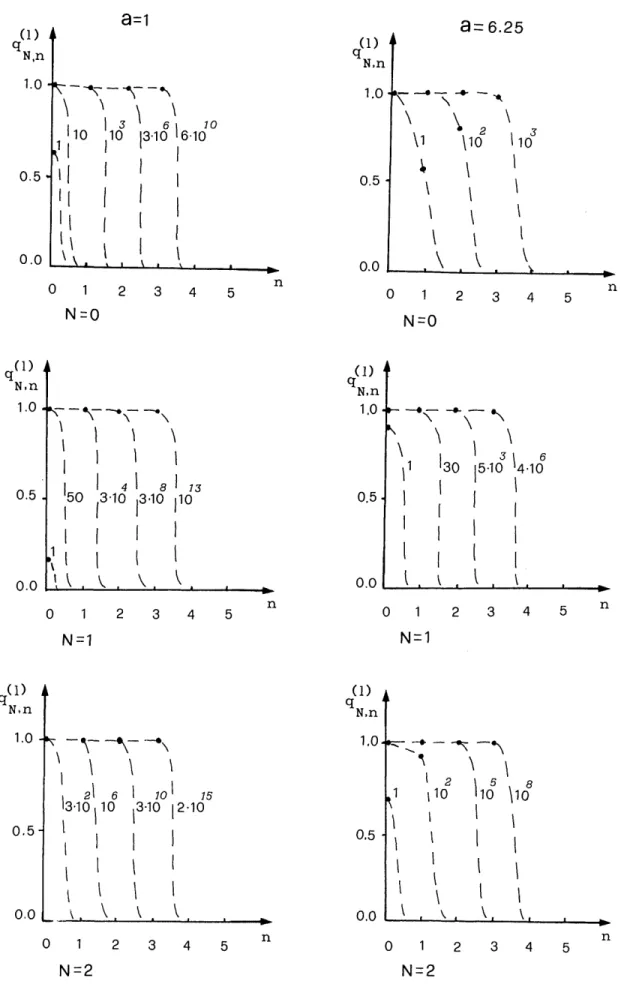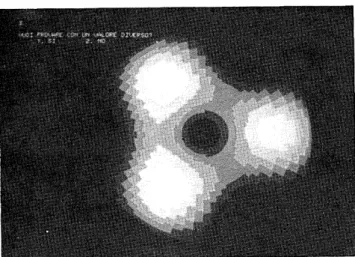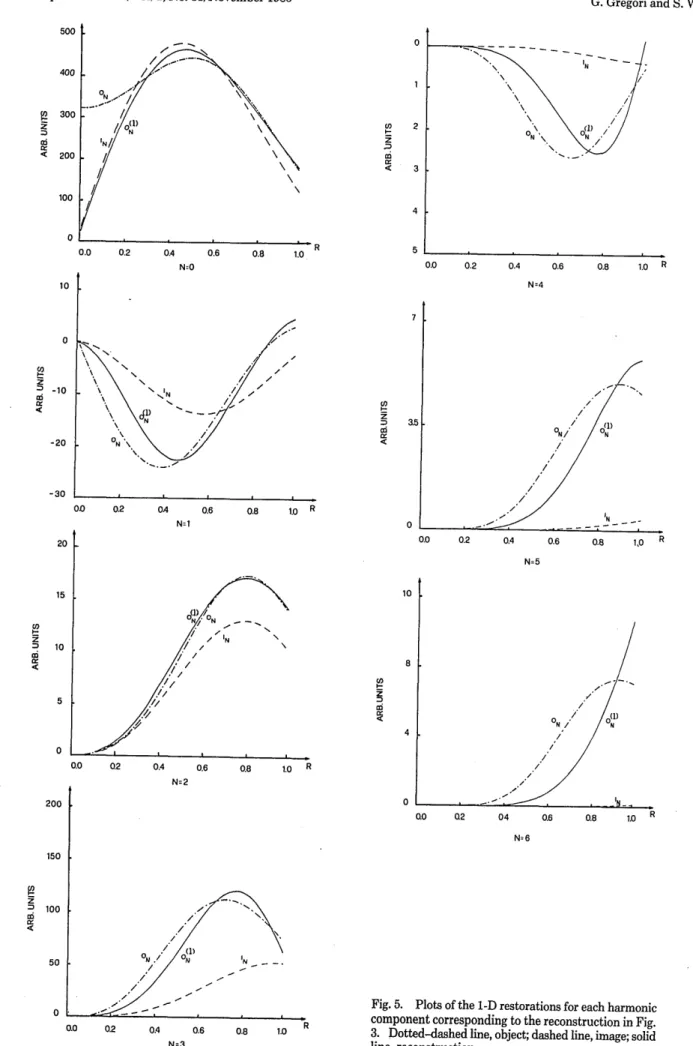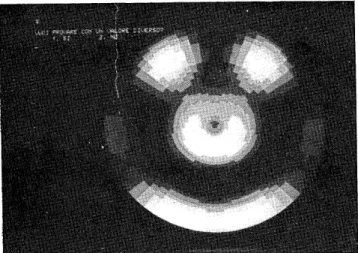New one-dimensional iterative approach to restoring
two-dimensional circularly band-limited images
G. Gregori* and S. Wabnitz
Fondazione "Ugo Bordoni" and Istituto Superiore delle Poste e Telecomunicazioni, Viale Europo 160, Rome,
Italy
Received December 2, 1984; accepted June 20, 1985
A new method for the restoration of two-dimensional (2-D) images obtained through a circularly band-limited
sys-tem is given. Object and image are decomposed into circular harmonics, and it is observed that the imaging syssys-tem acts separately on each harmonic. We show that superresolution is, in practice, attainable with a small number of one-dimensional iterations. The method presents several advantages on the conventional 2-D algorithms of the
Gerchberg type. The computing effort in particular can be much reduced. Performances of our method on com-puter-generated images are presented.
1. INTRODUCTION
In this paper we present a new approach to restoring images obtained through a circularly band-limited optical system.
Superresolution of the image of a finite object produced by
arbitrary low-pass nonnegative pupils in coherent and inco-herent illumination has been a topic of current interest (see,
for example, Refs. 1-4) since a simple iterative method was introduced by Gerchberg in 19745 and further analyzed6
'7and generalized8-13by others.
Although a complete restoration of the information
con-tained in the object spectrum is in theory possible only in the
noise-free case with an infinite number of iterations,6 a
sig-nificant improvement to the effective resolution of a real noisy
image is achievable with a finite number of iterations if the
number of degrees of freedom, or the space-bandwidth
product, of the system is low.6
The techniques for superre-solution known at present are subject to strong limitations in
this sense. That is, the overall number of degrees of freedom,
in a typical multidimensional system, is so high that an
ex-pensive computational effort is required, involving a large number of elementary operations as well as long access time
in sequential access memories.
Observing that the circular symmetry of the system allows for the decomposition of the object-to-image relationship into
a denumerable set of one-dimensional (1-D) operators that
link circular harmonics of the same order, we will demonstrate here how a two-dimensional (2-D) restoration may be per-formed through a selected number of 1-D restorations, each
of them corresponding to angular information of interest in the particular image.
The convergence of the method, as well as the effect of a
finite number of iterations on the image restoration, will be
analyzed by means of the generalized prolate spheroidal wave
functions.'4
The efficiency of the method will be checked by means of the restoration of some computer-generated test images. We
have achieved good reconstructions by iterating only those few
harmonic components that were present in the image in a
significant way.
The main advantage of our 1-D approach is that, depending
on the effective space-bandwidth product of each harmonic, it allows for a differentiation of the restoring effort.
2. IMAGING THROUGH CIRCULARLY SYMMETRIC SYSTEMS
We remember how a 2-D shift-invariant imaging system can
be generally characterized by means of its point-spread function s(x, y):
(1) where i(x, y) is the output of the system (image) corre-sponding to the given input o(x, y) (object).
In the Fourier space Eq. (1) becomes
Ftij(v,, v2) = F{s(vi, V2)Fjol(vi, V2), (2) where Ffgj denotes the Fourier transform of the function g(x,
y).
As soon as we consider circularly symmetric systems, it is
advantageous to introduce polar coordinates, both in the data spaces (r, 0) and in the Fourier space (co, ).
In these coordinates the Fourier transform of g(x, y) is ex-pressed by
27r +X
F~gI(cw, ) =
f
X g(r, )exp[i27rcor cos( - 0)]rdrdO. (3)Let s(r, 0) s(r) be the point-spread function of our system. From Eq. (3) its transfer function will be 27rS(c), where S(w)
is the zero-order Hankel transform'5 of s(r),
S(c) = f rs(r)JO(27rr)dr. (4)
In the following we consider a class of objects of finite support belonging to L2(R), where R = (x, y): x2+ y2 <
I1.
0740-3232/85/112046-08$02.00 © 1985 Optical Society of America
Vol. 2, No. 11/November 1985/J. Opt. Soc. Am. A 2047 Let us develop object and image into circular harmonics:
o(r, 0) = A, ON(r)exp(iNO), 0 r 1, 0 0 _ 27r;
N=--i(r, 0) = A, IN(r)exp(iNO), 0 r _ +, 0 0 _ 27r.
N=--c
(5) The Fourier transforms of the above series are written as
Flo1(w, 0) = 27r (-i)NON(w)exp(iN0),
N=-2
fli(, 0) = 2r A,(-i)NIN(w)exp(iNP),
N=--for 0 c _ +0, 0 _ 0 _2X, (6) where ON( () and IN(w) are the nth-order Hankel transforms
of ON(r) and IN(r),
Now the kernel SN [see Eq. (10)] becomes
I
SN,a(p,r) = 4a2 wpJN(2rvMrw)JN(27vMpw)do.
(13) Conventional 2-D iterative image restorations use expan-sions in terms of the set of eigenfunctions of 3a, i.e., the so-lutions of the equation
Ak,10k,1(X) = (9.0kl), (14)
where Ak,l is a doubly numerable set'4 of real and positive numbers such that Akl 2 /Ak+1,l+j with i, j 2 0, while lbkl(x)}
are the generalized spheroidal prolate wave functions, or-thogonal on R and complete in L2(R).16
I) If we introduce the operator T that truncates to the circle
R, the imaging relation [see Eq. (11)] leads to the
expres-sion
'khl = Ak,10k,l (15)
ON(O) = rON(r)JN(27rwr)dr, (7) with inverse transform
IN(r) = 472
fo
cIN(co)JN(2rwr)dco. (8) From Eqs. (1) and (2) we immediately obtain thatIN(r) = 87r3 CS(O9)N(o)JN(27r o)r)dc. (9)
Substituting Eq. (7) into Eq. (9), we have a relationship between harmonics of the same order,
IN(r) = At SN(p, r)ON(p)dp O(NON)(r), (10)
9N being a shift-variant integral operator.
By now the problem is reduced to the inversion of a count-able set of 1-D integral operators. This problem can be
ap-proached in different ways; we adopt an iterative procedure.
Through the eigenfunction analysis of the operators involved we reach a deep comprehension of the reconstruction
pro-cess.
3. THE CIRCULAR BAND-LIMITING
OPERATOR: EIGENFUNCTIONS AND EIGENVALUES
In the particular case of a circular low-pass system we have
i(x) = J Sa(-y)(y)dY= (9aO)(y), (11) where x, Y denote radius vectors in the object and image planes and where
Sa () =
S
exp(2riV x)d. (12)Here Pa is the pupil defined by Pa - (v1, v2): p12 + v22 < asr 2 SO that a is the space-bandwidth product of the system, that is, the product of the object support area times the ac-cessible Fourier area a = w2vm 2 (vM is the maximum
trans-mittable frequency).
connecting the coefficients of the expansions
O(W) = E Ok,1lk,l(y),
kl
Ti(
) =
E Ik,11 k, (),k ,l
x inR. (16)
Now, if we use the result'4that expanding +I(x) = i(r, 0) in circular harmonics
06(r, 0) = E RN(r)exp(iNO),
N=-O
the RN(r) satisfy (we may only consider N 2 0)
7N,nRN,. (r) =
f
JN(2rvMpr)RNn (p)pdp,where YN,n and MIN,n are related by
AN = 4a2'YN, . 2.
(17)
(18)
(19) Comparing Eqs. (18) and (13) we immediatly see that the functions RN,, (r) satisfy the equation
AN,nRN,n(r) = (0N,aRN,n)(r). (20) In other words {RN,n (r)I is a complete set of eigenfunction for SN,a
4. ITERATIVE RESTORATION OF HARMONIC COMPONENTS
For each harmonic component N, we may expand IN(r),
ON(r) into the set {RNfn(r)I complete in L2(0, 1):
IN(r) = E iN,nRN,n(r),
n=O
ON(r) = E: ONnRNn(r).
n=O
Then Eq. (10) simplifies to
(21)
iN,n = I-tN,nON,n. (22) G. Gregori and S. Wabnitz
a=1
(1) q N,n.
\->
13
6 1 10 13 10 I I 1 II I I Ia=
6.25
1.0j4 \
,*
I 1 0 1 I I -1 0 1 2 3 4 5 N=O (1) N,n 1.0 I I 1 \ I 1 1 1I
41
8113
50 1310 1310P I I I I ' ' 1 1 I I~~. 0 1 2 3 4 5 0.5 0.0 n \1 \10 Vi \o 0.5-I \ \ Inn
\
\
n 3 I. 0 1 2 3 4 5 N=O316
15' 4l 1 1 0 1 2 3 4 5 n N=1 (1) N,n 1.0 \\
I 10 1 15 1310 1210 1 I I I I 0.5-0.0 1 110 lO 0 10 I I I I I I I I I\,K.,
I
n
0 1 2 3 4 5N=2
nFig. 1. Plots of qf,(l) = 1 - (1 - N,,,)' for different harmonics and different space-bandwidth products a. The number of iterations I is
given close to each curve [for convenience, continuous curves join the values of qN,y () for the same 1].
(1) qN ,n 1.0 -0.5 0.0 n
q(l)
N ,n 1.0. 0.5. 0.0 q(1)Nn
0.5-0.
L
21 6 13 10 10 I I 0 1 2 3 4 5 - -, . _ , _ , V.V 1 -0t. -- --\\
. . . . .which ensures the convergence of our iteration to the object's
harmonic ON (r).
<4"
~~~~~~~~~It
is perhaps worth pointing out that the convergence justproved does not guarantee a meaningful result in any practical
situation when the image is not perfectly known. This
be-~~~,, ~~~~havior
is due to the well-known ill posedness of themathe-matical problem of inverting a Fredholm integral equation of the first kind [Eq. (1)1.
<4<4 "~~~~~~~~~
~Theory
of regularization can be used in order to restore the~~"<"
'4<~~~~ continuity of the inverse operator SON-, by introducing4'
~~~~suitable
constraints on the set of acceptable solutions.'0
On the other hand, in any practical reconstruction only a
p4
~~~~~~~~finite
number of iterations is performed, and this regularizesthe problem' 7 as well. Comparison of Eqs. (21) and (26) shows that ON (1)(r) differs from ON (r) in having each coeffi-cient ON,n multiplied by the weighting factor qN,,
Fig utilzed in eample 1.In 2 Obect Fig. 1 we have plotted the values qN~ (1) for the first
values of N, n and different space-bandwidth products a; the
iteration number 1 is given close to each curve.
We have qN,nl(0=AIN,n. As the number of iterationsl1in-creases, the qN~ (1) approach one, showing a characteristic step-function behavior with respect to n, that is, the weighting factors are very close to unity for any index value between zero
and a certain critical value, after which they drop to nearly
zero values.
4 ~~~~~~~~~~As one can see, for a given space-bandwidth product a, the
critical index decreases with increasing harmonic index N. This signifies that, as is obvious, the higher the harmonic is, the more degraded the associated information is. If we
con-sider the image corrupted by noise uniformly distributed over
/ ~~~~~~~~~~the angular harmonics, the modes that are multiplied by small
Fig. 3. Reconstruction of the image in Fig. 4 obtained by iterating the first seven harmonics according to Table 1.
Now, defining the operator KN,a as
(IZN,aO)(X f
3
I(X -Y)- SN,a(X,Y)1o(Y)dY, (23) where 6(x is the Dirac delta function, we may use the formal identity [see Eq. (10)]IN(r) = ON(r) - (1ZN,aON)(r) for r in [0, 1] (24)
to get the iteration scheme6
ONM'(r) = IN(r) + [KN,aON( 1')Ir)
= (KN~~aJIN)(r), IN~~r) + Z ~Fig. 4. Im age of the object in Fig. 2 (a 10).
1=1
~~~~~Table
1. Numbers of Iterations Settled with OurONM')(r = IN (r), (25) Criterion for Each Harmonic of the Objects in
Examples 1 and 2 Using Eqs. (21) and (22), we may write Eq. (25) as
ON(t)(r) = E ONnqNfnq(l)RNn(r), (26) n=O
where
qNn(1) = 1 - (1- Nn) 1* (27)
Since 0 < IIN,n < 1, it holds that
lim qN,n (l) = 1 for each N, n,
I- +c
Harmonic Numbers of Iterations
(No.) Obj. 1 Obj. 2
0 69 37 1 291 169 2 63 339 3 420 68 4 3498 289 5 6784 2375 6 796 1362
Vol. 2 No. 11/November 1985/J. Opt. Soc Am. A 2049
G. Gregori and S. Wabnitz
500 400 300 200 100 0 10 0 z M 2 3 5 0.0 0.2 04 0.6 0.8 1.0 N-O N=4 z m 0.0 02 OA 0.6 0.8 1.0 R N-I a5 0 10 8 (0 z 0.0 Q2 0.4 Q6 0.8 1.0 R N-2 (1) 0.0 0.2 04 0.6 0.8 1,0 N=5 0 50 0 N=3 QO Q2 04 Q6 08 1.0 R N-6
Fig. 5. Plots of the 1-D restorations for each harmonic
component corresponding to the reconstruction in Fig.
3. Dotted-dashed line, object; dashed line, image; solid
line, reconstruction. z -10 -20 -30 20 15 a: 'C 10 0 200 150 z m 100 0.0 Q2 0.4 0.6 0.8 1.0
Vol. 2, No. 11/November 1985/J. Opt. Soc. Am. A 2051 n 1 iON') (kAr)
k=1
ON(1)(kAr)12/ fo 1ONv'1'(kAr)12 (29)
k=1
m being the number of radial divisions, becomes smaller than a given treshold.
Example 1
The object consists of three Gaussian functions centered at different points around the origin of the plane (x, y) and
"esidessimulating three bright spots (Fig. 2). The minimum relative
improvement for iteration is set to be 10a7.
The reconstruction (Fig. 3) of an image (Fig. 4) obtained
through a system with space-bandwidth product a = 10 is
calculated by iteration of the first seven harmonics only. The Fig. 6. Reconstruction of the image in Fig. 8 obtained by iterating higher-order harmonics of the object are in fact virtually 1he first seven harmonics according to Table 1. suppressed by the system so that their contribution to the
image is nearly zero. As it can be seen in Table 1, the optimal
number of iterations is strongly different from one harmonic to the other. A comparison among the one-dimensional
res-torations of the first seven harmonics (Fig. 5) reveals how the
relative resolution improvement with respect to the image
harmonics IN(r) increases with the order N, as we outlined
in Section 4.
Fig. 7. Object utilized in example 2.
eigenvalues [see Eq. (22)] will not in practice be recoverable.
Besides varying the harmonic N, we need different numbers of iterations to recover a mode with a specified index n. For
a = 1 about 1 = 10, 50, 300 iterations are necessary to bring the coefficients qN,1(1) close to one for the harmonics N 0, 1, 2, respectively (Fig. 1). Restoration of higher-order harmonics
would likely mainly amplify the noise and thus should be Fig. 8. Image of the object in Fig. 7 (a =15). avoided.
A different number of iterations is also required for each harmonic to obtain the same relative resolution improvement.
For example, with a 6.25 about 200 iterations are required
for the harmonic N =0 to double the resolution (i.e., the
number of modes that are present in the image), whereas for N = 1 we need fewer than 30 iterations.
5. EXPERIMENTAL RESULTS
The proposed method has been tested on some 2-D target
objects. A number of noise-free images were created on a polar grid consisting of 64 angular divisions and 40 radial di-visions of the domain R.
For each harmonic we evaluated the optimal number of iterations by means of the following criterion. Iteration of the Nth harmonic ends as soon as the relative improvement
for iteration eN (1, defined as Fig. 9. Image of the object in Fig. 7 (a =30).
G. Gregori and S. Wabnitz
I I
Example 2
The reconstruction (Fig. 6) of the target object shown in Fig. 7 is obtained from an image with a = 15 (Fig. 8). Again, only the first seven harmonics turned out to be significantly present
and recoverable. The threshold for the relative improvement
eN(1) is now set to 10-6, and the corresponding numbers of
iterations are reported in Table 1.
The same considerations as in example 1 on the numbers
of iterations and resolution improvement for each harmonic are still valid.
For comparison we also report the image (Fig. 9) of the
object in Fig. 7 obtained through a system with
space-band-width product a = 30. It can be seen that this image (Fig. 9) and the reconstruction (Fig. 6) are qualitatively similar. Therefore we conclude that the obtained superresolution has
allowed for a near doubling of the effective space-bandwidth
product. On the other hand, it should be clear that the in-crease of resolution depends on the angular spectrum of the
object.
6. CONCLUSIONS
Using the circular symmetry of the problem, 2-D iterative superresolution is performed through separate I-D recon-structions of the harmonic components of the object imaged through a circularly band-limited system.
Our method has the following important advantages:
1. It avoids interpolation errors when image data are given on a polar grid.
2. The number of required computations may also be considerably reduced. If, for instance, we need L iterations to recover a particular high-frequency angular information with a conventional Gerchberg algorithm," the number of operations will be proportional to LM2 log2 M (M2 is the
number of data), since each iteration requires a 2-D fast Fourier transform (FFT). On the other hand, if we iterate
separately only the harmonic components of interest, we need a number of iterations of order LM2
for each component, since the operator N,a is shift variant and L is allowed to vary from
one harmonic to the other. For large M and strongly varying
L the reduction of complexity is relevant.
3. Our algorithm also noticeably reduces the access time
to data stored in a sequential memory, because of its lowering
the dimensionality of the problem. With this method, the
handling of large matrices as is required by methods based on 2-D FFT can be avoided.
4. If the image is noisy, then iteration of high harmonic
components would produce only an amplification of the noise.
This iteration is implicit in the 2-D algorithms and imposes a limit on the number of iterations. The limit can be
con-siderably increased, though, in the 1-D restoration of selected
harmonic components whose signal-to-noise ratio is not too
low.
A minor disadvantage of the method can be seen in the in-creased complexity of evaluating the kernel SN,a [Eq. (13)]
used in our iteration, in comparison with the kernel Sa [Eq. (12)]. However, this does not significantly affect the per-formances of the algorithm, since the values of N,a are to be
computed only once for each harmonic component.
Superresolution of some computer-generated images has been performed to show the validity of the proposed method. These experimental results confirm how the computational effort is, in general, strongly different from one harmonic to the other. Consequently, one can optimize the number of iterations to be carried out for each harmonic indepen-dently.
ACKNOWLEDGMENTS
We wish to thank F. Gori, University of Rome, and D. Psaltis,
California Institute of Technology, for helpful discussions. We also thank the Department of Physics of the University of Rome for making available to the authors its computing
facilities.
* Present address, Department of Mathematics, Stanford University, Stanford, California 94305.
REFERENCES
1. J. L. C. Sanz and T. S. Huang, "Unified Hilbert space approach
to iterative least-squares linear signal restoration," J. Opt. Soc.
Am. 73, 1455-65 (1983).
2. A. M. Darling, T. J. Hall, and M. A. Fiddy, "Stable, noniterative
object reconstruction from incomplete data using a priori
knowledge," J. Opt. Soc. Am. 73, 1466-1469 (1983).
3. L. S. Joyce and W. L. Root, "Precision bounds in superresolution processing," J. Opt. Soc. Am. A 1, 149-168 (1984).
4. M. Bertero, C. de Mol, E. R. Pike, and J. G. Walker, "Resolution in diffraction-limited imaging, a singular value analysis. IV. The case of uncertain localization or nonuniform illumination of the object," Opt. Acta, 31, 923-945 (1984).
5. R. W. Gerchberg, "Super-resolution through error energy re-duction," Opt. Acta 21, 709-720 (1974).
6. P. de Santis and F. Gori, "On an iterative method for super-res-olution," Opt. Acta 22, 691-695 (1975).
7. A. Papoulis, "A new algorithm in spectral analysis and band-limited signal extrapolation," IEEE Trans. Circuits Syst. CAS-22, 735-742 (1975).
8. D. C. Youla, "Generalized image restoration by the method of
alternating orthogonal projections," IEEE Trans. Circuits Syst.
CAS-25, 694-702 (1978).
9. G. Cesini, G. Guattari, G. Lucarini, and C. Palma, "An iterative method for restoring noisy images," Opt. Acta 25, 501-508 (1978).
10. M. Bertero, C. de Mol, and G. A. Viano, "The stability of inverse
problems," in Inverse Scattering Problems in Optics, Vol. 20 of Topics in Current Physics, H. P. Baltes, ed. (Springer-Verlag,
Berlin, 1980), pp. 161-214.
11. R. J. Marks, II, "Gerchberg's extrapolation algorithm in two di-mensions," Appl. Opt. 20, 1815-1820 (1981).
12. D. C. Youla and H. Webb, "Image restoration by the method of
convex projections: part 1-Theory," IEEE Trans. Med.
Imaging MI-1, 81-94 (1982).
13. M. I. Sezan and H. Stark, "Image restoration by the method of convex projections: part 2-Applications and numerical results," IEEE Trans. Med. Imaging MI-1, 95-101 (1982).
14. D. Slepian, "Prolate spheroidal wave functions, Fourier analysis
and uncertainty. IV: Extensions to many dimensions;
gener-alized prolate spheroidal wave functions," Bell Syst. Tech. J. 43, 3009-3057 (1964).
15. A. Papoulis, Systems and Transforms with Applications in
Optics (McGraw-Hill, New York, 1968).
16. F. Riesz and B. S. Nagy, Functional Analysis (Ungar, New York, 1951).
17. F. Gori and G. Guattari, "Signal restoration for linear systems
with weighted inputs. Singular value analysis for two cases of low-pass filtering," Inverse Problems 1, 67-85 (1985).
P-c.
0
G. Gregori and S. Wabnitz Vol. 2, No. 11/November 1985/J. Opt. Soc. Am. A 2053
G. Gregori
S. Wabnitz
G. Gregori was born in Rome, Italy, in 1961. He received the Laurea degree in electrical engineering in 1984 from the University of Rome. After his
gradua-tion he spent a year at the Fondazione
"Ugo Bordoni," Rome, on a research
grant. He is currently a graduate stu-dent in mathematics at Stanford
Uni-versity, Stanford, California. His
re-search interests include nonlinear optics and electromagnetic inverse problems.
S. Wabnitz was born in Rome, Italy, in 1958. He received the Laurea degree in electrical engineering in 1982 from the University of Rome and the M.S. degree in electrical engineering in 1983 from the
California Institute of Technology, Pas-adena. He joined the Fondazione "Ugo
Bordoni," Rome, in 1983. His research fields include electromagnetic inverse
problems, propagation in optical fibers, and nonlinear optics.



